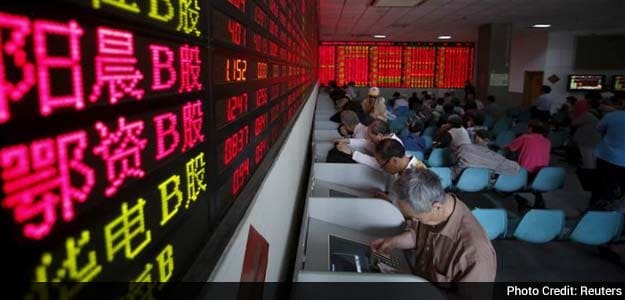
Tokyo: Asian
shares were subdued in early trade on Friday, but still on track for a
steep weekly loss in the wake of China's shock currency devaluation
earlier in the week.
Crude oil futures remained under pressure, plunging to 6-1/2-year lows after data revealed a big rise in U.S. stockpiles, fuelling fears of a growing global glut.
MSCI's broadest index of Asia-Pacific shares outside Japan was down about 0.1 per cent, poised to end the week down 2.6 per cent.
Japan's Nikkei stock index fell 0.3 per cent, and was down about 0.9 per cent for the week.
Investors awaited Friday's yuan fixing to see if China's central bank would set its official guidance rate lower for a fourth day. The People's Bank of China (PBOC) set its rate nearly 2 per cent lower on Tuesday, a move it said was aimed at making its foreign exchange system more responsive to market forces.
The PBOC reassured investors on Thursday, saying there was no reason for the yuan to fall further given the country's strong economic fundamentals, helping to calm investors who pared holdings of risk assets for fear of a currency war.
The dollar's moves in U.S. trading were subdued, which meant the PBOC could set Friday's reference below Thursday's 6.4010, at around 6.39, said Sean Callow, senior currency strategist at Westpac.
"While this would simply be a stable outcome - fully consistent with how the PBOC has explained the 'new system - it would generate a wave of headlines about a stronger yuan and should support risk appetite," Callow said in a note.
A midpoint in the 6.40-6.41 area might be unsettling for risk assets, he said.
The dollar was steady on its Japanese counterpart at 124.41. The euro edged up about 0.1 per cent to $1.1158, moving back toward a one-month peak of $1.1215 scaled on Wednesday.
The dollar came under pressure this week as the market instability caused by China's devaluation curbed expectations that the U.S. Federal Reserve's long-awaited interest rate increase would come as early as its Sept. 16-17 meeting.
But strong U.S. retail sales data on Thursday provided evidence in support of views that the Fed is on track to hike.
U.S. retail sales rose in July and were revised up for June, while the trend of weekly jobless claims pointed to a tightening job market.
In commodities trading, crude oil futures extended sharp losses that pushed oil prices to levels not seen since early 2009, when the financial crisis was wreaking havoc on markets.
U.S. crude settled down 3 per cent at a new 6-1/2-year low as a big rise in U.S. stockpiles intensified worries over a growing global glut.
U.S. crude oil was down 0.4 per cent at $42.07 a barrel in early Asia trade, while Brent slipped 0.2 per cent to $49.11, ahead of Friday's expiry of its front-month contract
Crude oil futures remained under pressure, plunging to 6-1/2-year lows after data revealed a big rise in U.S. stockpiles, fuelling fears of a growing global glut.
MSCI's broadest index of Asia-Pacific shares outside Japan was down about 0.1 per cent, poised to end the week down 2.6 per cent.
Japan's Nikkei stock index fell 0.3 per cent, and was down about 0.9 per cent for the week.
Investors awaited Friday's yuan fixing to see if China's central bank would set its official guidance rate lower for a fourth day. The People's Bank of China (PBOC) set its rate nearly 2 per cent lower on Tuesday, a move it said was aimed at making its foreign exchange system more responsive to market forces.
The PBOC reassured investors on Thursday, saying there was no reason for the yuan to fall further given the country's strong economic fundamentals, helping to calm investors who pared holdings of risk assets for fear of a currency war.
The dollar's moves in U.S. trading were subdued, which meant the PBOC could set Friday's reference below Thursday's 6.4010, at around 6.39, said Sean Callow, senior currency strategist at Westpac.
"While this would simply be a stable outcome - fully consistent with how the PBOC has explained the 'new system - it would generate a wave of headlines about a stronger yuan and should support risk appetite," Callow said in a note.
A midpoint in the 6.40-6.41 area might be unsettling for risk assets, he said.
The dollar was steady on its Japanese counterpart at 124.41. The euro edged up about 0.1 per cent to $1.1158, moving back toward a one-month peak of $1.1215 scaled on Wednesday.
The dollar came under pressure this week as the market instability caused by China's devaluation curbed expectations that the U.S. Federal Reserve's long-awaited interest rate increase would come as early as its Sept. 16-17 meeting.
But strong U.S. retail sales data on Thursday provided evidence in support of views that the Fed is on track to hike.
U.S. retail sales rose in July and were revised up for June, while the trend of weekly jobless claims pointed to a tightening job market.
In commodities trading, crude oil futures extended sharp losses that pushed oil prices to levels not seen since early 2009, when the financial crisis was wreaking havoc on markets.
U.S. crude settled down 3 per cent at a new 6-1/2-year low as a big rise in U.S. stockpiles intensified worries over a growing global glut.
U.S. crude oil was down 0.4 per cent at $42.07 a barrel in early Asia trade, while Brent slipped 0.2 per cent to $49.11, ahead of Friday's expiry of its front-month contract

No comments:
Post a Comment